Or, general tips and tricks for pitching on Twitter, and how pitching SFF is different from pitching other genres.
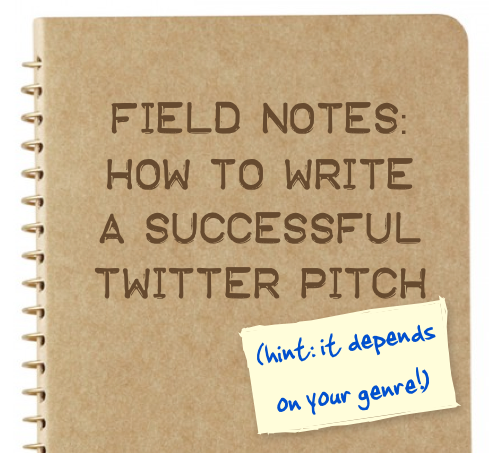
This is going to be a long one, folks. Skip around as needed!
Update from 2021—We Need Diverse Books no longer uses the #ownvoices hashtag or label. Read why.
Update from 2018—I wrote this post in 2014, and it’s been so cool seeing these practices put to work in Twitter pitches over the last four years. It’s been unreal knowing that some are now books I own or can pre-order! Some things have changed (like contest rules and the character limit on tweets), and I’ve added clarification where I felt it was needed, but much of the advice I gave then I’d still give now.
Update from PitchMAS—when pitching in a general pitch party, your hashtags matter so much more. Make it easy for an agent to find you, or they never will. I tried searching for different genres during the party so I could retweet—I couldn’t find them because people weren’t using effective search terms. Use age category tags and genre tags, plus relevant and appropriate keywords (like “Bechdel” or “WNDB”—see my notes on references below).
Contents
- Well-Known Twitter Pitch Events
- Tips for Pitching on Twitter
- The Importance of Hashtags
- After the Pitch Party
- My Personal SFFpit Results
- Analysis of my Personal SFFpit Results
- Final Thoughts
Well-Known Twitter Pitch Events
- PitMad, for pretty much everybody, 4x/yr*
- PitchMAS, for pretty much everybody, 2x/yr**
- SFFpit, for Science Fiction and Fantasy works, 2x/yr
- AdPit, for Adult works (as in, not PB, MG, or YA works)
- DVPit, for pitches from marginalized voices that have been historically underrepresented in publishing, each April***
*(see PitMad’s new rules! Only 3 pitches total, not twice per hour. Make sure you are tweeting what will catch your genre’s agents’ attention, and use hashtags!)
**Looking at my winning pitches from PitchMAS, hashtags and keywords mattered most, then other references, then stakes.
***Read DVPit’s about page before deciding whether you qualify.
Tips for Pitching on Twitter
Favorite Resources for Twitter Pitching:
- Advice from Literary Agent Ella Kennen
- Advice from Literary Agent Terrie Wolf
- Advice from Literary Agent Carly Watters
- Requested Pitches from January PitMad 2013
The following advice stems from a series of Tweets published December 8th, 2014. Follow me on Twitter! @LaraEdits is devoted to writing and editing tips. If you aren’t on Twitter, you can still bookmark my feed.
A hook can be interesting MC, conflict, stakes, fresh premise, or voice. Pitch whichever is strongest in your novel.
It’s impossible to convey how unique your MC, setting, conflict, premise, or voice is all at once, in one tweet. Which is the MOST different compared to other novels?
If your pitches are falling flat, adjust your selling point. You might be trying to pass a swan story off as a duck one.
Twitter pitches are so short, you have to pick your focus. Character, stakes, conflict, premise, voice…pick two per pitch.
That way, if an agent goes to your feed, they don’t see the same pitch repeated, and they see that 1) your novel is complex, 2) you can pitch in a variety of ways (i.e. you’re a skilled writer), 3) you are open to variance in writing (i.e. you’d be willing to do necessary rewrites)
During these Twitter Pitch Parties, you can usually pitch once or twice per hour. That’s 12 to 24 different opportunities to pitch! Vary them by focus and by hashtags, but only use relevant hashtags. (This rule has now changed for PitMad)
I use the free version of Buffer to 1) schedule my pitches beforehand and 2) see their effectiveness afterward.
I’d recommend at least 6 different pitches, with different focuses, repeated with different hashtags (if more than two are applicable). And out of those 6-12 differently focused, no-words-wasted, intriguing pitches, tweet your most fantastic ones at peak times. That is, as soon as the pitch party starts, and at lunch time EST, lunch time PST, and after-work hours. There will be more tweets then, and that’s likely when agents will do the most browsing, so your tweets then matter most.
There will be too many tweets for each agent to read. That’s why you need to use hashtags effectively (see below). You can always query those you think are a good fit for your novel (check #MSWL).
The Importance of Hashtags
The reason you need to use genre or age category hashtags in Twitter pitch parties is because that’s how agents filter through the feed. They can’t see every tweet! One agent was looking for Adult Fantasy works. She searched “#SFFpit #A #Fa” and that’s how she found my tweet.
KNOW THY GENRE. If you write speculative fiction, read my Straightforward Guide to Science Fiction and Fantasy Sub-Genres.
There are two deciding factors in assigning an age category. One is the age of the protagonist. One is the age of the audience, based on the age of protagonist and the content of the novel. If your protagonist is an adult, you can’t pitch it for kids. If your content is too mature for kids, it needs to be pitched at a higher age category. If the tone is too simple or cutesy for the intended audience, that needs to be fixed. Agents will reject YA novels if it “sounds MG.” (See When Voice and Genre Don’t Match)
What is New Adult? New Adult is a contemporary construct that stems from the post-adolescent phenomenon. If your novel contains an 1) 18-to-20-something protagonist with a 2) contemporary mindset 3) transitioning between adolescent and adult life, then you can pitch it as #NA. Note, though, that this started as a subcategory of romance, and some agents and publishers still consider it “YA romance + more sex” OR “adult romance with younger MCs.” NA is all about navigating the world as a newly-released-into-the-wild adult. It concerns itself with firsts: first job, first home, first “serious” relationship.
NA is new, because historically, people were children, and then, after they hit puberty, they were adults. In the 20th century, more people attended school past puberty, and eventually (post WWII), people were divided into children, teenagers, and adults. Now, people aren’t considered adults until 25, which leaves us with a 19-to-25-year-old category: new adults.
Calls for Diversity: #WNDB, #OWN, and #DVpit
If you qualify, you can use the #WNDB hashtag, which stands for the #WeNeedDiverseBooks hashtag but gives you considerably more characters to work with.
Update from 2021—We Need Diverse Books no longer uses the #ownvoices hashtag or label. Read why.
(2018 update, since I absolutely needed additional clarification here:
- Remember that diversity is NOT a trend. It is not a label you “add in” as an afterthought to sell more books. If you are wanting to write characters who are marginalized in a way you are not, invest your time in researching setting, culture, attitudes, worldview, and language, and invest your money in sensitivity reads.
- If you aren’t a marginalized author writing about a character sharing that marginalization, do not use #own or #ownvoices. Secondhand experience is not enough. Read DVpit’s notes on marginalization here.
- Some voices are not yours to borrow, and some stories are not yours to tell. Do we need another LGBT coming-out story written by a cishet person? Should another white American write from a slave’s perspective? Do not profit off another’s pain, especially if your ancestors or your greater community were the ones who caused the pain.
)
After the Pitch Party
What to do after Twitter pitch parties: STOP. Celebrate agent interest and newfound friends, analyze which pitches worked best, research agents.
DON’T:
Jump into querying too soon.
Query more than 1 agent per agency.
Query agents / presses that seem shady.
DO:
Query only agents / presses you’d trust your MS (& career!) with.
Take time to research agents and tailor your query for each. Try to send within the week.
If you sit at the bar and keep using the same line over and over again, it’s not going to be very successful unless you’re Ryan Gosling. You need to tailor your pitches based on the type of agent you want to represent you.
SFFpit Results
For the sake of this post, all times given are in CST Central Time.
Remember, #SFFpit is for writers and agents of speculative fiction. Agents looking for other genres might act differently. In fact, I expect they will. Be sure to read my analysis below.
Dan Koboldt, host of SFFpit, posted his results of the 2014 Twitter Party. A quick look:
- 641 authors tweeted 6,000 pitches
- 32 literary agents made 355 requests
- 11 small presses also participated
- 32% of authors received at least one request from an agent
- 14% of authors got requests from 2 or more agents
My results
- I tweeted 24 times, once every half hour from 7am–7pm.
- I pitched 22 completely different pitches for the same manuscript. I re-pitched two.
- During those 12 hours, I received 143 RTs and 17 requests—10 from agents, 6 from small presses (one small press requested twice).
While I will certainly be looking into the small presses, this specific blog post is going to consider what the agents were looking for.
37.5% (9/24) of my pitches received requests from both agents and small presses.
25% received requests from literary agents. Here are the 6 winning pitches:
7:47 am, pinned to the top of my page, 26 RTs and 5 agent requests
Tagged: Premise, Voice, Reference
9:47 am, 9 RTs and 1 agent request
Tagged: Premise, Reference
12:47 am, 1 RT, 1 agent request, 1 press request
Tagged: Premise, Stakes
1:17 pm, 1 RT and 1 agent request
Tagged: Character, Premise, Reference
2:17 pm, 4 RTs, 1 agent request, 1 press request
Tagged: Premise, Stakes, Reference
3:17 pm, 1 RT, 1 agent request, 1 press request
Tagged: Voice, Premise, Reference
Audience Choice—Three pitches received 10 or more RTs but yielded no agent response:
Tagged: Stakes, Voice
Tagged: Stakes, Premise, Reference
Tagged: Stakes, Voice
The tweet that received the most RTs was actually the first and third “Audience Choice.” It was the clear winner in critique groups, and I thought for sure it would be my most successful pitch. 29 total RTs … zero agent response.
SFFpit Analysis
For the sake of this post, I will only be analyzing the requests from agents, not small presses. Realize that this is an extremely small sample and is particular to my genre and premise. To make this really scientific, I’d need to analyze every agent favorite per category. If anybody wants to go ahead and do that, please do! If you want to do the same analysis I’m doing here, blog about it and comment below with a link so readers can see your responses as well.
Analysis of Timing
I started off the day with what I thought were some of my strongest pitches. My second post did better than my first, so I immediately pinned that to the top of my page. It went on to be my most successful pitch of the day, likely because it was pinned to the top of my page.
If you post great ones at the beginning of the day, they will be retweeted throughout the day, getting your pitch in front of more people.
The chart below shows the time the number of RTs and Requests (both agent and small press) by time posted.
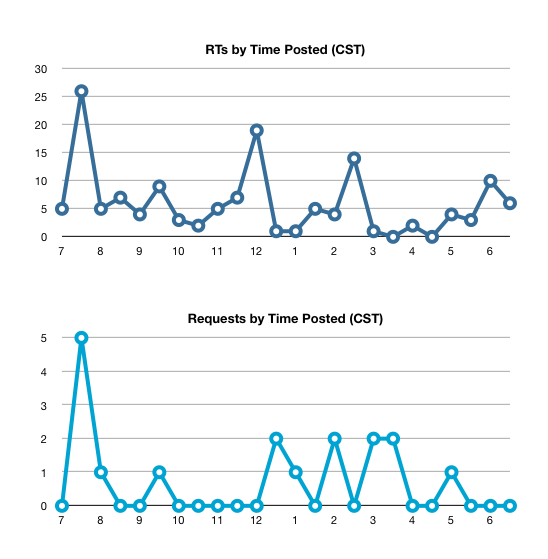
I don’t know how to see when the agents were online, but I vaguely remember a surge of notifications at around 10 am CST, and in the afternoon, around 3 pm CST.
Analysis of Focus
I tagged my 22 different pitches by their focus:
- Conflict
- Character
- Stakes
- Voice
- References (comp titles, pop culture references, social references, keywords from manuscript wishlists)
- Premise
As you can see, the audience favorites were definitely those pitches with clear stakes and a strong voice.
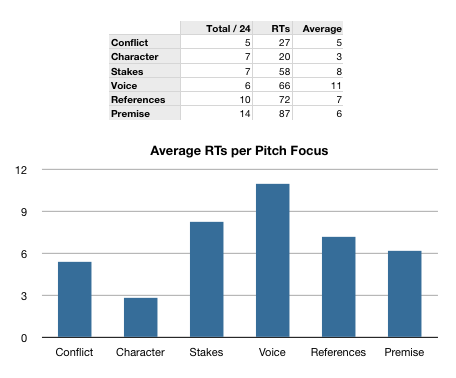
While most advice I see regarding pitching focuses on conflict and stakes, the success rate of my pitches suggests that isn’t necessarily what agents are looking for, at least in SFF, at least in my genres.
Two guesses.
One: Because the past decade has given us multimillion dollar Science Fiction and Fantasy franchises, agents who represent these genres receive more derivative work than manuscripts from other genres. That’s why, today, in SFF, a fresh premise is important.
Two: Speculative fiction often features a clear antagonist. Whether it’s good vs evil, humanity vs aliens, or one girl against the world, it’s generally assumed that conflict and stakes are a given.
So if you aren’t writing SFF, don’t think that your pitches don’t need stakes!
Granted, my tweets that focused on stakes didn’t do bad at all, but they certainly didn’t do as well as ones with other focuses, as you can see:
All ten agents who requested on one of my tweets selected one tagged “premise.” Nine selected one with a reference of some sort, six chose one with strong voice.

However however however!
Not all of my “premise” tweets were successful. Let’s look at the success rate of each focus based on my 24 tweets.
Out of all six tags, the tweets with references (I’ll go through the references below) had the highest success rate at 50%. Of my 10 tweets with references, 5 got requests.
Those are pretty great odds.
The odds get even better when I start combining tags.
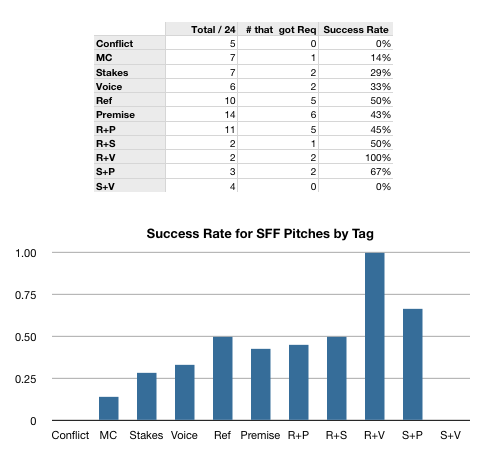
Now, here my sample size is showing, but of the 2 tweets that had both strong voice and a culture reference, 100% got a request.
And I’m thinking that the 0 requests for my Stakes + Voice pitches is more proof that pitching SFF just isn’t the same as pitching other genres. Those poor little babies. Maybe they’ll do better during PitchMAS.
At bigger sample sizes, the results might not be the same, but one thing’s for certain:
No matter your genre, your pitches with strong voice and apt pop culture references are most likely to get noticed.
On Voice
It takes practice to have a natural voice to your writing. Voice = diction = word choice. Use specific nouns, verbs, and adjectives. See my posts on diction here.
On Comp Titles and Pop Culture References
I’ve spent months trying to find the best comparative titles for my novel. Here’s how to do it.
HOW TO CHOOSE COMP TITLES
1—Choose a novel that matches your novel in at least 2 of the following categories: genre, premise/plot, time, place, protagonist type, conflict, tone, audience, event.
2—Find another work that matches both your book and your first comp title in two or more of those categories.
My most successful pitch was The Princess Bride + Lost in Austen. While it isn’t a novel (I’d love to read it!), Lost in Austen matches my novel in genre (literary fantasy) and premise/plot (contemporary MC goes to a historical, fictional world, tries to get home, falls in love reluctantly with a local). The Princess Bride matches my novel and Lost in Austen in genre, and it matches my novel in tone (the irreverent humor), audience, time and place (medieval Europe-ish), and event (the wedding crashing).
Remember that when you are pitching a book to an agent, you are pitching a book to a reader. A reader that reads professionally. You’re also pitching to a professional. A professional that needs to make a living.
With that in mind, here are my 7 tips for including references in Twitter pitches:
- Be relevant—references to classical literature and old books aren’t as successful as ones published in the last two–three years. Show that you’re aware of what’s in the market today.
- Be literary—make at least one of your comparative titles a novel, if possible. Show that you read your genre.
- Be realistic—your references need to work for your novel. See “How to Choose Comp Titles” above.
- Be humble—Don’t claim to be the next [Insert Famous Author Here]. Instead, use one of their recent books as a comparative title.
- Be specific—compare your characters to well-known characters (I picked Taylor Swift and Chuck Bartowski)
- Be savvy—if you can make a reference to a still-current movement that affects publishing, do, but only if it applies to you or your manuscript (Examples: WNDB, LGBTQ, Bechdel and Mako Mori feminism tests. Read my note on calls for diversity in the hashtag section.)
- Be awesome—refer to something geeky or a cult classic that hasn’t been mentioned for a while and will stir up nostalgia. Everybody mentions Black Panther and Buffy and recent blockbusters. Give me more Veronica Mars, Donnie Darko, more 80s and 90s and 00s references.
On Fresh Premises and Trendy Topics
By “fresh premise” I mean pitching something that the market isn’t currently saturated in. Pay attention to agents who tweet their responses to queries (#tenqueries, #querylunch, #500queries), and you’ll see what they are receiving a lot of. Right now, winter 2014, they are receiving a lot of paranormal, dystopians, fairy tale retellings, and urban fantasy. Ghosts, angels, demons, werewolves, mermaids, psychics, empaths.
So if you’re pitching something trendy, focus on what makes your novel different, what makes yours unique, not on what makes it trendy.
The good news about publishing is that it’s cyclical. So you can try to grab the readers now, while they are hungry, by self-publishing, or you can wait a couple of years until the big publishers come back to it. Remember that anything that is trendy now, won’t be in two years when the books being written now are being put out on bookshelves. You either have to be a year or two ahead of the market, or a couple years behind. I heard one editor at a big 5 publisher say she was ready to start looking at vampire books again. Give it time. (And please don’t ask me which editor. I don’t remember because it wasn’t applicable to me personally. If you have an agent, s/he should know.)
(Note: In April 2018, agents were aflutter on Twitter actively looking for more vampires. See?!)
On Hashtags, Again
Use them. Of the agents who requested from my pitches, here are the total number of requests they made during the SFFpit event, in descending order:
40, 34, 33, 33, 7, 6, 5, 3, 3, 3
If you take into consideration all the favorites and the 32 agents who participated, a single agent, on average, chose only 11 pitches. Out of six thousand.
Final thoughts
Research what agents are looking for. See which Wish Lists are compatible with your novel, and then try to guess what that agent might search for during a pitch party. If one of your favorite agents is looking for space opera, use that hashtag, or if there isn’t a designated hashtag list, use those words in one of your pitches. That way when an agent searches “#SFFpit space opera,” your pitch will pop up.

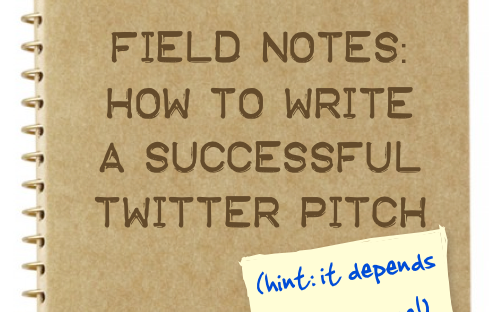
This is an awesome post! Excited to see you dig into the numbers, especially because you officially got the most requests from literary agents in this December’s #SFFpit.
Wow! Thanks!
And hey, bonus point for almost spelling my name correctly 🙂
Crap. Sorry. Totally knew there was supposed to be a D there, too. I’ll fix it!
I will have to take a better look at this 🙂 This is amazing! My ‘voice’ was missing from all my pitches, and now I know I have to add it in. I think I was too focused on what I read about some twitter pitching events, where I ended up questioning everything I mentioned in the tweet and then tried to add too much in :S Then it just sounded too matter-of -fact and conversational…
If your book has a matter-of-fact sound to it, then that’s fine! There’s a “what you see is what you get” expectation that if there’s a distinct voice to the pitch, that should translate to the novel. I like conversational. There’s only so much you can do in one tweet, so make a few strong on voice and don’t beat yourself up about the rest.
I shall do that next time 🙂 My book has a lot more personality than my tweet. I have two opportunities, but I think with your advice, my true voice will shine through 🙂
Reblogged this on One Writer's Journey by Chris Owens and commented:
Pitching strategy advice and analytical breakdown of successful pitches – well worth reading.
Reblogged this on New Writer Discoveries and commented:
A thorough and thoughtful analysis regarding twitter pitch contests.
Reblogged this on Lara Willard and commented:
#PitMad is this week. I wrote this post in 2014, and it’s been so cool seeing these practices put to work in Twitter pitches over the last four years.
Some things have changed (like rules and the character limit), but other things are still the same. One thing I did have to include for 2018 was an addendum to the part about vampires… ha!